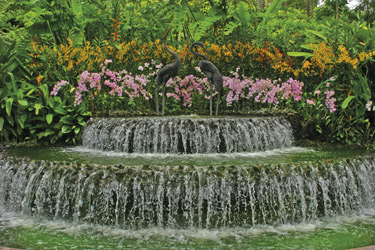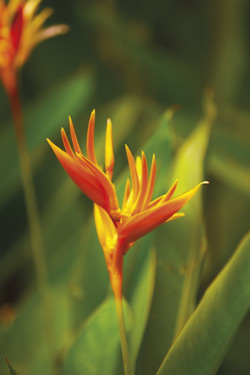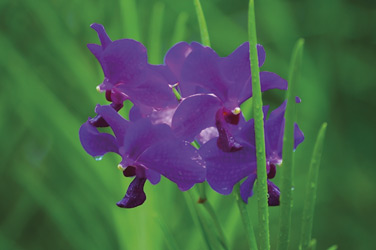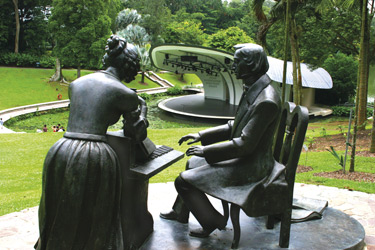SINGAPOREíS GREEN SECRET WEAPONLast year, the Singapore Botanic Gardens, awarded the title of "Asia's Best Urban Jungle" and a three-Michelin star rating in the Michelin Green Guide, proudly celebrated its 150th anniversary.
 At the anniversary event, Minister Mentor Lee Kuan Yew, who is the driving force behind Singapore's development as a Garden City, credited greenery for the state's economic growth. As part of his efforts to find "some dramatic way to distinguish ourselves [Singaporeans] from other Third World countries", MM Lee made it a priority to achieve a "clean and green" Singapore at a time when it was facing plenty of other challenges during the early stages of independence. The big plan was "to show investors that this was a well-organised place, <…> that this is a country where the administration works, where there is a system," MM Lee recalled.
 Surprisingly, bringing experts and samplings from all over the world was not the most difficult part of the campaign. Rather, the greatest challenge was to change the mentality of people, to implant the idea of the common value of a spruce green city, relates MM Lee in his Memoirs. An anecdote of a wealthy doctor who was caught digging up a valuable Norfolk Island pine planted along the streets shows how much needed to be done.
Surprisingly, bringing experts and samplings from all over the world was not the most difficult part of the campaign. Rather, the greatest challenge was to change the mentality of people, to implant the idea of the common value of a spruce green city, relates MM Lee in his Memoirs. An anecdote of a wealthy doctor who was caught digging up a valuable Norfolk Island pine planted along the streets shows how much needed to be done.
Much of the credit for the "greening" of the nation should be given to the Singapore Botanic Gardens, which have been lending its expertise and resources to transform Singapore into a Garden City, its initial tagline, and now Garden within the City, the name of the most recent government initiative.
History
It's common knowledge that botanic gardens are the descendants of medicinal herbal gardens of monasteries or ancient pharmacists.
 Later, they became a showcase of exotic plants brought from all over the world, a botanist's laboratory or an open-air classroom for the public. In the 19th century, botanic gardens reacquired their initial practical function. "Medicine, commerce, agriculture, horticulture, and many valuable branches of manufacture, would derive considerable advantages from … such a system," wrote John Lindley, head of the Royal Gardens Committee, in his 1838 report arguing that the botanic gardens of the entire British empire should be brought under the control of Kew Gardens (one of the most recognised botanic gardens in the world) and made useful to the nation.
Attempting to establish the first botanical and experimental garden on Government Hill (today's Fort Canning Hill) in 1822, Sir Stamford Raffles, founder of Singapore and a keen naturalist, had anticipated the idea. His goal had been to introduce the cultivation of economic crops such as cocoa and nutmeg. However, the garden was closed in 1829, after Raffles' death.
Later, they became a showcase of exotic plants brought from all over the world, a botanist's laboratory or an open-air classroom for the public. In the 19th century, botanic gardens reacquired their initial practical function. "Medicine, commerce, agriculture, horticulture, and many valuable branches of manufacture, would derive considerable advantages from … such a system," wrote John Lindley, head of the Royal Gardens Committee, in his 1838 report arguing that the botanic gardens of the entire British empire should be brought under the control of Kew Gardens (one of the most recognised botanic gardens in the world) and made useful to the nation.
Attempting to establish the first botanical and experimental garden on Government Hill (today's Fort Canning Hill) in 1822, Sir Stamford Raffles, founder of Singapore and a keen naturalist, had anticipated the idea. His goal had been to introduce the cultivation of economic crops such as cocoa and nutmeg. However, the garden was closed in 1829, after Raffles' death.

The Singapore Botanic Gardens as we know them today were founded by the Agri-Horticultural Society in 1859, which planned it as a leisure garden and ornamental park with flower shows and horticultural fetes. In 1874, the Gardens became Royal and their scientific mission evolved when the colonial government deployed Kew-trained botanists and horticulturists to administer them.
Now one of the leading international institutions for tropical botany research, Singapore Botanic Gardens is a scientific collection, nursery and conservation area of rare plants, a scientific experimental area and educational centre. Affectionately known as the "People's Garden", it is also a favourite recreational space for Singaporeans and visitors alike.
Main Attractions:
National Orchid Garden
It houses more than 1,000 species and 2,000 hybrids of orchids. The entrance fee of S$5 will gives you the opportunity to see the rarest breeds including those that are normally only found in tropical highland areas. There's also a VIP Orchid Garden with different hybrids named after VIPs who have visited the garden.
The Three Lakes
The 63.7-hectare garden is divided into different zones including three small lakes: Swan Lake, which welcomes passers-by with its magnificent Flight of Swans sculpture, Eco-Lake and Symphony Lake, with the Symphony Stage standing elegantly at its centre. Symphony Stage is an outstanding building whose roof resembles the shape of a leaf or flower. It is the venue for "Concert in the Park" performances by the local symphony orchestra and international entertainers, which are free for the public. A small sculpture of Chopin is placed near the lake.
For the Little Ones
Both parents and kids will love the 1.5-hectare Evolution Garden, which tells the story of the forming of the earth and how plants help us in our modern-day lives, while Jacob Ballas Children's Garden is Asia's first children's garden specially designed for kids to have fun and to ignite their interest in nature.
Sports in the Gardens
 The relaxing ambiance of the Gardens makes it a very popular place for jogging and tai-chi group workouts. Bird-lovers will also be happy as they ay be able to spot many seasonal birds. The relaxing ambiance of the Gardens makes it a very popular place for jogging and tai-chi group workouts. Bird-lovers will also be happy as they ay be able to spot many seasonal birds.
The Singapore Botanic Gardens are open to the public from 5 am to 12 midnight daily and entry is free of charge.
Text Natalia Makarova
Photos Gleb Osipov
|
 +65 6696 7068
+65 6696 7068
 info@meridian103.com
info@meridian103.com
 PDA
PDA
 +65 6696 7068
+65 6696 7068
 info@meridian103.com
info@meridian103.com
 PDA
PDA

I am Rameshkumar from Madurai, Tamilnadu
I have completed M.Sc. Botany. I am very interesting to work with there. If there have any vacancy please consider me.
Rameshkumar, 2013-04-07